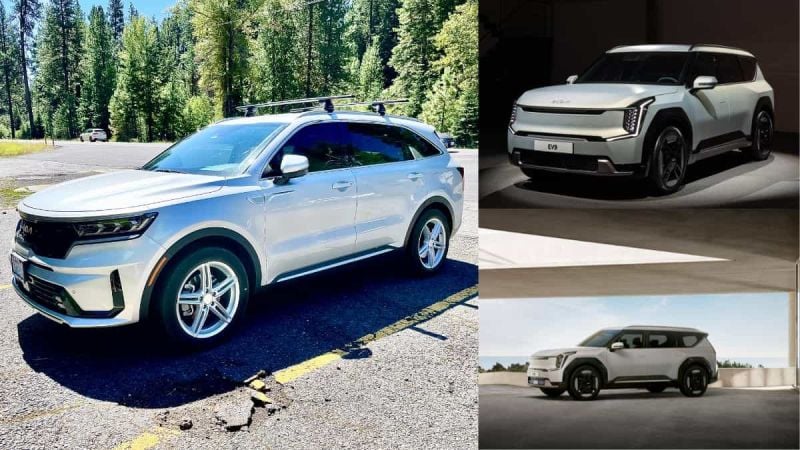Electrek.com just shared the MPGe figures for all 5 variants of the forthcoming Kia EV9 that buyers can put a deposit down on starting next week. The MPGe values for these 5 variants range from 80 for the most powerful, most expensive GT-Line variant with the larger of two battery options and AWD, to 89 for the least powerful, lower priced RWD Light Long Range variant also with the larger of two battery options. Car & Driver explains that MPGe is an energy efficiency metric established by the EPA in order to “relate the amount of energy expended by alternative fuel vehicles to that of traditional gas-powered variants”. The EPA chose to establish this because the public understands “miles per gallon” and that, according to those they surveyed, was how they wanted to see the equivalence expressed. However, MPGe doesn’t necessarily give you direct cost comparison ability since there is a significant variance both in the costs of electricity versus gasoline and in the “mix” of fuel one might use if one or more of the vehicles being compared happens to use both electricity and gasoline (which all plug-in hybrids (PHEVs) are capable of). So, MPGe is really a better tool for determining the relative energy use efficiency of two or more vehicles. For example, if I compare a traditional gasoline only vehicle that gets 32 MPG combined to a PHEV that gets 79 MPGe and an EV that gets 121 MPGe, I can see that the EV is clearly rated as the most energy efficient option of the three, in terms of how much energy it will consume to travel a given distance. But that still doesn’t tell you how much you are going to spend fueling a plug-in vehicle, rather it tells you how far each vehicle might be expected to travel on the energy equivalent of what 1 gallon of gasoline contains (33.7 kWh).
I can tell you from experience though, it’s still a terrible metric and here’s why: my Kia Sorento PHEV has a calculated lifetime average of 3.22 miles per kWh while driving on electricity only. I could go 108.5 miles, on electricity only, on 33.7 kWh (though I would have to stop to recharge my battery 3 times to do so). My Tesla Model 3 has a calculated lifetime average of 4.1 miles per kWh, which means I could go 138.17 miles on 33.7 kWh (which wouldn’t even use up half a full battery charge). If I wasn’t going to stop and recharge my Kia, the most I’ve gotten on a full charge of its battery is 45.2 miles, and if I were to use up the balance of the 33.7 kWh/1 gallon as gasoline (which I estimate would take me another 25 miles), then I would be comparing the energy consumption and efficiency figures for my two plug-in vehicles in terms that may more clearly represent the differences in efficiency. That would roughly come out to traveling 70.2 miles in my Kia PHEV versus traveling 138.2 miles in my Tesla on the same energy contained within 1 gallon of gas/33.7 kWh. Since I only occasionally drive my Kia distances that are greater than it can go on a full charge of its battery though, in the real world I have better results than that strict comparison suggests. But I digress.
This piece is about Kia’s new EV9 and its MPGe figures, which I find to be a bit on the low side. Given the EV9’s figures, I wonder how efficient and how costly to fuel this new flagship EV might be compared to my own, similarly sized Sorento PHEV, which has an EPA rated 79 MPGe (very close to the EPA’s numbers for the EV9). I figure other potential buyers might find it useful to compare them to some real world experience too.
I’d like to call out that I may not drive the same way anyone else does. I tend to drive my PHEV very gently and I recharge it often. You may have very different driving habits so I am going to use my real world Sorento PHEV figures as the base scenario, and extrapolate some variances for comparison. Comparing my real world figures then, to drive approximately 15,000 miles, I used an estimated 2,444 kWh and 195 gallons of gas (adding up to about 53% of my miles driven on electricity). That combined cost, given a kWh price of 10 cents and an averaged price of gasoline at $4.39, comes out to $1,100.47 ($244.42 + $856.05) or a per mile cost of 7.3 cents per mile. The most efficient EV9, with an 89 MPGe score and an optimal average of 2.85 miles per kWh consumption figure (my estimate given the EV9 is larger and weighs 1,200 pounds more than my Sorento) would consume 5,279 kWh at the wheels, or about $528 at 10 cents per kWh, equating to 3.5 cents per mile. That is roughly half the fueling costs of my PHEV, however I have to point out that about 47% of my miles were highway miles which means in an EV9, if the miles were the same, I would have covered the majority of those miles paying much higher per kWh rates using public fast (or medium speed) charging. Thus I would say that my actual 15,000 mile fuel cost in the EV9 would have been higher than my PHEV (which is ironic, considering). Here’s why: the CCS fast charging that the EV9 can use typically costs between 36 and 49 cents per kWh. Depending on which I used for approximately 2,100 kWh worth of charging I estimate would have been needed, I would have paid $896. Combine that with the $318 I would have used to charge my EV9 at 10 cents per kWh, and I end up paying $1,214 for about 15,000 miles of driving. This is my base. If I would have used more expensive CCS fast charging for only about 10% of my total miles, I would have paid about $700 total in electricity. If instead I drove 65% of my miles using CCS fast charging, and the rest at 10 cents per kWh, then I would have spent $1,643 on electricity to drive my EV9. If I drove the less efficient 80 MPGe EV9, I would spend more on electricity, period.
So there you have it. As long as you are comparing similarly sized plug-in vehicles, and depending on what you pay for gas and electricity, a PHEV could cost less to fuel than an EV (assuming half or more of your miles are covered on electricity, as per my example). Of course just because the PHEV may cost less to fuel than an EV, doesn’t mean that it is more efficient, in the overall consumption of energy. The electric motor is vastly more efficient than the gasoline engine though, and in terms of energy consumption, if you happen to be one of those people who rarely drive distances longer than what a gallon or two of gas will cover (if for example you might only use 10-20 gallons of gas annually, in a PHEV), a PHEV could actually end up being roughly equal to or even more efficient than an EV.
Which would you prefer and why? Please leave your questions and comments below.
Images courtesy of Justin Hart and Kia.
Justin Hart has owned and driven electric vehicles for over 15 years, including a first generation Nissan LEAF, second generation Chevy Volt, Tesla Model 3, an electric bicycle and most recently a Kia Sorento PHEV. He is also an avid SUP rider, poet, photographer and wine lover. He enjoys taking long EV and PHEV road trips to beautiful and serene places with the people he loves. Follow Justin on Torque News Kia or X for regular electric and hybrid news coverage.












Comments
I have heard that the…
Permalink
I have heard that the distribution of electricity is very inefficient, with about half being lost. If you change your car with one Kwh, two Kwh would have to be generated.
Right away I am going to do…
Permalink
Right away I am going to do my breakfast once having my breakfast coming yet again to read additional news.